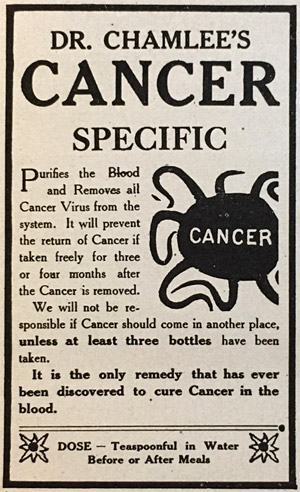
A typical advertisement for a fraudulent mail order cancer “cure,” highlighted in the American Medical Association’s Nostrums and Quackery (1912).
This summer, I spent a week in Chicago examining the files of the American Medical Association’s Bureau of Investigation. The contents illustrate the full range of weird health-related beliefs found in the 20th century, and it is interesting to watch how these beliefs track with historical events in the development of medicine and to see the role the AMA played in defining what was medicine and what was not. Having sampled the contents of this archive, I can say that there are entire careers in skepticism and the history of pseudoscience to be made excavating those files.
In the 19th century, popularly available health remedies were regulated, as far as I can tell, principally by the consciences of the people who made and sold them. Remedies were sold by pharmacists to anyone who asked for them, and there was really no limit to what could be said to sell these nostrums, either on the label or in advertising. There was no requirement to disclose the contents of a treatment. So let’s say you had a “catarrh” treatment. Catarrh is a word that encompasses all sorts of sinus blockages. If you were to take a treatment for a stuffy head, you could almost expect the remedies to have an alcohol base and a variety of other medically active substances mixed in with it. A health remedy might be up to 25% or more alcohol, and it would not have to be disclosed on the bottle. That alcohol might be mixed with morphine, chloroform, opium, cocaine, and/or caffeine, in undisclosed concentrations and without quality control. Sure, you might forget about your stuffy nose, but you might well become a coke addict, an opium eater, or an alcoholic.
In the early 20th century, two forces came together that brought about some changes in the public interest. The first was the temperance movement, which, as you might imagine, had concerns about the high alcohol content of quack preparations. The second was muckraking journalism—and boy was there ever muck to be raked. In 1905, the same year that Upton Sinclair’s The Jungle appeared and exposed truly ghastly conditions in the meatpacking industry, a series of articles by Samuel Hopkins Adams appeared in Collier’s magazine that examined quackery. These were collected in a single volume called The Great American Fraud, that was republished and distributed cheaply by the AMA. Adams is scathing, naming names, shaming publishers who advertised quack remedies, revealing common fraudulent practices, and printing the contents of proprietary medicines when he could get them.
A discussion of The Great American Fraud series could, honestly, get its own entire post, but it’s enough to say here that it was in keeping with the reform-minded journalism of the day and helped prepare the way for the passage of the Pure Food and Drugs Act in 1906. The Act outlawed mislabeling and required disclosure of the presence of addictive and potentially dangerous substances like cocaine and opium in medical preparations. That same year, an underappreciated doctor by the name of Arthur Cramp began writing about quackery for the AMA. In 1914, Cramp joined the AMA’s newly formed Propaganda for Reform Department, which would eventually become AMA’s Bureau of Investigation. In consultation with AMA’s in-house chemists, Cramp made known the contents of various nostrums. He also gathered intelligence on hundreds of quacks around the country. Members of the AMA contributed mightily to Cramp’s enormous collection (as did a lack of restrictions on sharing patient information). Nonetheless, this collection was the backbone of the American Medical Association’s attempt to systematize and professionalize medicine. Cramp corresponded with state medical Boards, government agencies, and law enforcement, and it would be surprising if legal actions were ever taken against quacks without consultation of Cramp and his collection.
People realized fairly quickly that the 1906 Pure Food and Drugs Act had some severe shortcomings. Quacks weaseled around the labelling requirements effortlessly and still did massive harm, which was documented in Cramp’s other legacy, his 3-volume encyclopedic account of modern American quackery, Nostrums and Quackery and Pseudo-medicine. (Read the 1912 edition of Vol. 1 online.) The first volume was published in 1910 and the final in 1936, following his retirement from the AMA. There was no consensus on what should replace the 1906 law. In September and October of 1937, however, over a hundred people died after taking an antibiotic preparation by the Massengill Company called Elixir Sulfanilamide, a sulpha drug with a yummy raspberry flavoring prescribed for sore throats. The antibiotic was suspended in diethylene glycol, an antifreeze poisonous to all mammals. At the time, there was no requirement that a drug be tested for safety before it was sold. Out of the ensuing debacle came the Federal Food Drug and Cosmetics act of 1938, which increased the regulatory authority of the FDA over what was said about drugs by promoters and required safety testing which would then be submitted to the FDA for approval.
Further regulation was put in place following the thalidomide debacle of the late 1950s and early 1960s, when a drug that could cause severe malformations in fetuses was approved in Europe for morning sickness. The only reason that the US largely dodged the thalidomide bullet was because Frances Oldham Kelsey, a regulator in charge of the thalidomide application at the FDA, repeatedly refused to grant approval for the drug despite industry pressure. In 1962 she was awarded the President’s Award for Distinguished Federal Civilian Service, the same year that the Kefauver Harris Amendment to the Food Drug and Cosmetics act passed. This further tightened controls, requiring drugs to not only be determined safe but also effective, during the approval process. Side effects needed to be documented and disclosed and new standards for consent in human trials were required. This effectively created the modern drug regulatory scheme that we are familiar with today.
As the practice of medicine developed in America from small independent offices of private practitioners to the large, insurance company dominated behemoth of doom that we have today, the role of the AMA changed too, and in 1975 the AMA’s Bureau of Investigation closed. At about the same time, in 1976, we see the first of a series of laws stripping authority from the FDA to regulate health products, an amendment that prevented the FDA from limiting the potency of vitamins and minerals and from classifying them as drugs. Legislators have chipped away at regulation ever since, culminating in the Dietary Supplement Health and Education Act, which relaxed regulations on complementary and alternative medicines, or what Arthur Cramp would have rightly called “health fraud.”
It’s here, with the benefit of a historical perspective, that I offer two recommendations for the future of regulation. First, having witnessed politicians and lobbyists inject their non-specialist positions into FDA decisions in the last few years to the detriment of patients, my feeling is that the FDA should be isolated from political meddling. Human health should not be a political football. Secondly, the FDA should also be broken up into two separate but unequal parts to eliminate a conflict of interest that lies at the heart of its operation, to protect both business concerns and patient concerns. As it stands, the protection of pharmaceutical interests has interfered with the transparency of regulation at the FDA, and it not only undercuts confidence in the FDA but has, I believe, prevented people interested in public health from monitoring the FDA’s performance. On the other side, public health protection should clearly be the paramount concern of regulators, so let’s uncomplicate things, and separate the business interests from the public health interests and make public health the overriding concern of regulators.











I don’t understand the comment about dividing the FDA into two. The FDA’s mission is to protect public health – PERIOD, not to protect business. Unfortunately, FDA is under lots of popular and political pressure to be business friendly (note the “21st Century Cures Act” that is likely to be pushed through in the lame duck Congressional session) but that is due to the anti-regulatory sentiment that is currently pervasive in this country. Reforming the FDA can do nothing without reforming the outside pressures to be business friendly.
I think the point of that suggestion by the author was to reorganize the FDA in such a way that its most important functions would be insulated from political pressure.
I’m reminded of SCOTUS; whatever effects political pressure causes for the Court, it doesn’t have any ability to affect the decisions made during specific cases.
Don,
That’s an important clarification. I think that an assumption or interpretation of mine, based on years of running my head against the wall trying to get basic information out of the FDA, sneaked out as a fact. Oops. :)
As I’ve been following one quack’s story in particular, I have often submitted FOIAs to the FDA, for instance, to see which trials are the ones that have been the cause of a researcher getting a warning letter. Or to see the review process by which specific trials got authorization. The most common reason that my requests are denied or information is redacted are because of proprietary information, often including even the code of the trial (trial BT-01, would be a brain cancer trial). I translated this as part of the mission, rather than as a downstream effect of bureaucracy and political interference. Thanks for the head’s up!
if you even express doubt the practicioner of obvious quackery or health superstition you are defined to have the “disease
of “Iatrogenic Brainwashing” and need them to “cure” you
Is is very wise to tell them to fuck off and see a real doctor
@ polistra:
Would you mind citing your sources, please?
Wikipedia article : Glutethimide. Brand names include Doriden.
My father was, I believe, a victim of quackery when he became addicted to the drug Doradin in the early 1960s. The drug, which was insufficiently tested, was given to him by his doctor as a safe sleeping pill, and he quickly became addicted. Doradin turned out to be so dangerous that it was taken off the market and classified as Schedule 1. In those days, the ignorance about addiction, and the stigma were ruinous. My innocent dad ended up losing his business, his family, and much of his sanity from this irresponsibly marketed drug.
The problem with this narrative is that many techniques called “quackery” by the fashion of one decade get “rediscovered” later. Electrotherapy was a useful technique in the 1880s, then became “quackery” from 1910 to 1980. In the ’80s it was “rediscovered” under new names like TENS. Now it’s standard practice. Same thing, new name, new fashion.